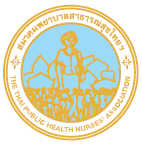THE EFFECTS OF SELF-EFFICACY ENHANCEMENT PROGRAM TO PREVENT LOW BACK PAIN OF OFFICE WORKERS IN A PRIVATE HOSPITAL, BANGKOK
Keywords:
low back pain, office workers/ self-efficacyAbstract
This quasi-experimental research using two group pre test-post test designs aimed to examine the effect of a self-efficacy promotion program on the prevention of low back pain and level of lower back pain. The degree of flexibility of the back muscles and the degree of ergonomic risk were also assessed. Purposive sampling technique was used to recruit 60 office workers with lower back pain in a private hospital . Participants were then divided into experimental groups (n=30) and the control groups (n=30) based on their work location. The experimental group participated in the program for 4 weeks and the control groups received usual care. Program consists of educational activities related to lower back pain, ergonomics and working with computer, work station arrangement, and practice of back muscle exercises. Data was collected using self-administered questionnaire, muscle flexibility assessment and rapid office strain assessment (ROSA). Descriptive statistics including frequency, percentage, mean, standard deviation, Wilcoxon signed rank test and Mann Witney U test were used to analyze the data.
The results revealed that after receiving the program, the experimental group had higher mean scores on perceived self-efficacy in reducing low back pain and, self-care behaviors than the pretest and higher than that of the control group (p < .001), degree of flexibility of the back muscles was also significantly higher than before the experiment (p < .001). However, low back pain and ergonomic risk score was not significantly different between groups. Findings suggest that self-efficacy enhancement programs for the prevention of low back pain was effective in promoting self-care behaviors and could be applied to those with similar job characteristics.
Key words : low back pain, office workers, self-efficacy , muscle flexibility, ergonomics risk
References
Farideh S, David C, Georgia N, Samaneh H . Predictors of low back pain in a longitudinalstudy of Iranian nurses and office workers. J Europe PMC. 2015; 51(2) : 239-244.
Laxmaiah M, Vijay S, Frank J , Ramsin M B, Joshua A H. Epidemiology of low back pain in adults. JINS. 2014; 17 (2) :3-10.
Department of Labor Protection and Welfare. The Importance of ergonomics [Internet].2019 [cited 2019 May 2]. Available from https://www.labour.go.th/index.php.
Thiphanan T, Phattharapan B, Wiphada S, Nithipong S, Kingkaew S, Eakpop J, et al. Factors Affected to Muscle Pain among Electronics Industries Industries Workers in Klongluang District Pathumthani Province. JEAU Heritage. 2019; 13(2):254-266. (in Thai)
Narkorn P, Somsamorn R, Komon B, Anupong S. The physical symtoms that occur from using computer of supporting staffs of Nakhon Phanom University. JSWU. 2014; 6(12): 26-38. (in Thai)
Wilawan C, Chawapornpan C, Thanee K. Ergonomic Factors and Prevalence Rate of Musculoskeletal Pain Among Workers in Semiconductor Industry in the Northern Region Industrial Estate. [Master’s thesis in Occupational Health Nursing program]. Chaing Mai, Chaing Mai University, 2006.
Usanee Fongsri. The effect of a self-empowerment program for the prevention of low back pain for patient transporters Siriraj Hospital. [Master’s thesis in Occupational Health Nursing program]. Nakhon Pathom, Mahidol University, 2006.
Sangsaikaew, A., Korcharoenyos, C., Donprapeng, B., & Sirisawat, M. The effects of promoting physical activity in daily life program on pain and disability in patients with non–specific low back pain. JPSU. 2019; 39(1), 93-104. (in Thai)
Burns, N. A.,Grove, S. K. Study guide for the practice of nursing research: Conduct, critique,and utilization. Open Access Library Journal. 2005; 3(10).
Bandura, A. Self-Efficacy: Toward unifying theory of behavioral change. Phychological Review. 1977b; 84(2): 191-215.
Anuda T, Warisara B. Effects of Ergonomics Health Promotion Program for behavioral modification to reduce the risk of work-related musculoskeletal disorders among the work of employees in an establishment Nongkhai. Journal of Environmental and Community Health. 2021; 6(3):38-44. (in Thai)
Piyaporn P, Weeraporn S, Thanee K. Effects of Ergonomic Intervention on Muscle Flexibility and Back Pain of Wood Carvers. Nursing Journal CMU. 2017; 44(3):77-89. (in Thai)
Maytinee K, Sunisa C. Ergonomic Risk Assessment in University Office Workers. Journal of KKU. 2014; 19(5):696-707. (in Thai)
Downloads
Published
How to Cite
Issue
Section
License
Copyright (c) 2023 Thai Public Health Nurses Association

This work is licensed under a Creative Commons Attribution-NonCommercial-NoDerivatives 4.0 International License.
บทความที่ตีพิมพ์และแผนภูมิรูปภาพถือเป็นลิขสิทธิ์ของวารสารพยาบาลสาธารณสุข (Thai Public Health Nurses Association)







